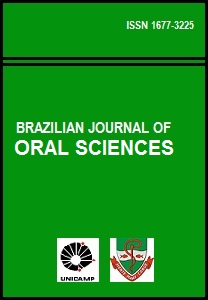Abstract
Aim: This study evaluated the morphological changes caused by internal bleaching agents on dentin surface. Methods: Twenty crowns of bovine incisors were cut into slabs that were randomly distributed in six experimental groups (n = 5), according to the bleaching agent used: G1 – sodium perborate + water, G2 – sodium perborate + 2% chlorhexidine gel, G3 – sodium perborate + 30% hydrogen peroxide, G4 – 30% hydrogen peroxide, G5 – 37% carbamide peroxide and G6 – gel base without carbamide. Two Control Groups were used: C1 with distilled water and C2 with 2% chlorhexidine gel. The specimens were immersed in the respective test bleaching agent and incubated at 37 °C for seven days. Following, they were prepared for scanning electron microscopy and five images from each tooth segment were recorded and analyzed for surface morphological alterations, by three previously calibrated examiners. Inter-examiner agreement was verified using the Kappa test. The rank averages obtained for the groups were subjected to Kruskal-Wallis analysis of variance at 5% significance level. Results: The analysis of the scores obtained indicated that all tested materials caused some morphological alteration on dentin, except for sodium perborate + water (G1) and Control Groups 1 and 2. Hydrogen peroxide and carbamide peroxide caused significantly more severe alterations (p < 0.05) to dentin structure, than the other bleaching agents evaluated. Conclusions: Sodium perborate-based pastes seemed to be the most harmless agent to dentin structures in non-vital tooth bleaching, while hydrogen peroxide solutions and carbamide peroxide agents caused the greatest alterations.The Brazilian Journal of Oral Sciences uses the Creative Commons license (CC), thus preserving the integrity of the articles in an open access environment.
Downloads
Download data is not yet available.

